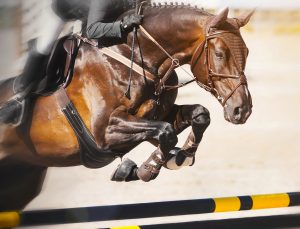Have you ever paused to consider the health of your horse’s joints? Joint health is not guaranteed so it is essential to manage your horse’s joints to minimise daily wear and tear. Check out our advice on how best to manage and be proactive in protecting your horse’s joints.
Joint health is not guaranteed and is unique to each individual horse; it can vary from breed to breed, be dependent on age, workload etc. It is essential to manage your horse’s joints to minimise daily wear and tear and limit potential problems. Being proactive when it comes to joint health will enable your horse to remain mobile, healthy and able to perform at their best.
Joint Structure
A very simple explanation of a joint is that it is the point where two or more bones meet. It is made up of a number of different parts that work together to allow the horse to move and bend in various ways. There are three types of joints in the horse: synovial joints, cartilaginous joints and fibrous joints. There are 18 synovial joints in the horse; it is the most moveable joint and most susceptible to injury (e.g. knee, hock). Within the synovial joint, where the two bones meet, the ends of each bone are covered in lubricated cartilage to allow for frictionless movement and shock absorption. In the joint capsule, there is an inner lining called synovial membrane which secretes synovial fluid for further lubrication to prevent friction. Equine joints are built to withstand the weight of the horse’s body, however when we add a rider to the equation, the situation changes. There is considerable strain put on a horse’s joints when riding so it understandable that equine joints need to be supported.
Joint Issues
In the normal day to day life of a horse, the joint cartilage is continually being broken down and replacement cartilage is being manufactured. However, this balance can be upset due to increased training, trauma, competition or simply old age. Other contributing factors can be diet, body condition, training regime, ground conditions as well as fitness level and muscle tone.
Joint Management
Careful management of your horse’s joints will help maintain mobility and performance, here are some top tips:
- Regular exercise and movement to encourage blood flow and keep joints supple
- Effective warm-up and cool down at exercise to avoid excess friction
- Weight management to ensure no excess strain on joints through extra body weight
- Balanced nutritional program to support the natural regeneration of cartilage
Nutritional Support
Joint supplements have been developed to provide targeted nutrition that supports healthy, functioning joints and easy mobility. While not all joint problems can be prevented, supplements may help reinforce the integrity of the joint capsule and the process of repair. Arthri Aid Equine Joint Mobility Supplement is a Glucosamine, Chondroitin, MSM and HA supplement aids the lubrication and helps to promote regeneration of the important shock absorbing tissues of your horse’s joints. It contains the following to ensure joint health:
- Glucosamine – an amino acid that assists in the body’s manufacture of cartilage
- Chondroitin – which assists in lubrication and shock absorption of the joints
- MSM – a naturally occurring sulphur compound which helps soothe knocks and improve joint mobility
- Hyaluronic Acid (HA)- is the principle constituent of Synovial Fluid, natures ‘oil for joints’
To conclude, horses are susceptible to joint issues of one kind or another and horse owners need to be mindful of this. However, with careful management and care equine joint health can be achieved for mobility, performance, and comfort for your horse.
For more advice and information, please contact our expert team on 051 304010 or here.



